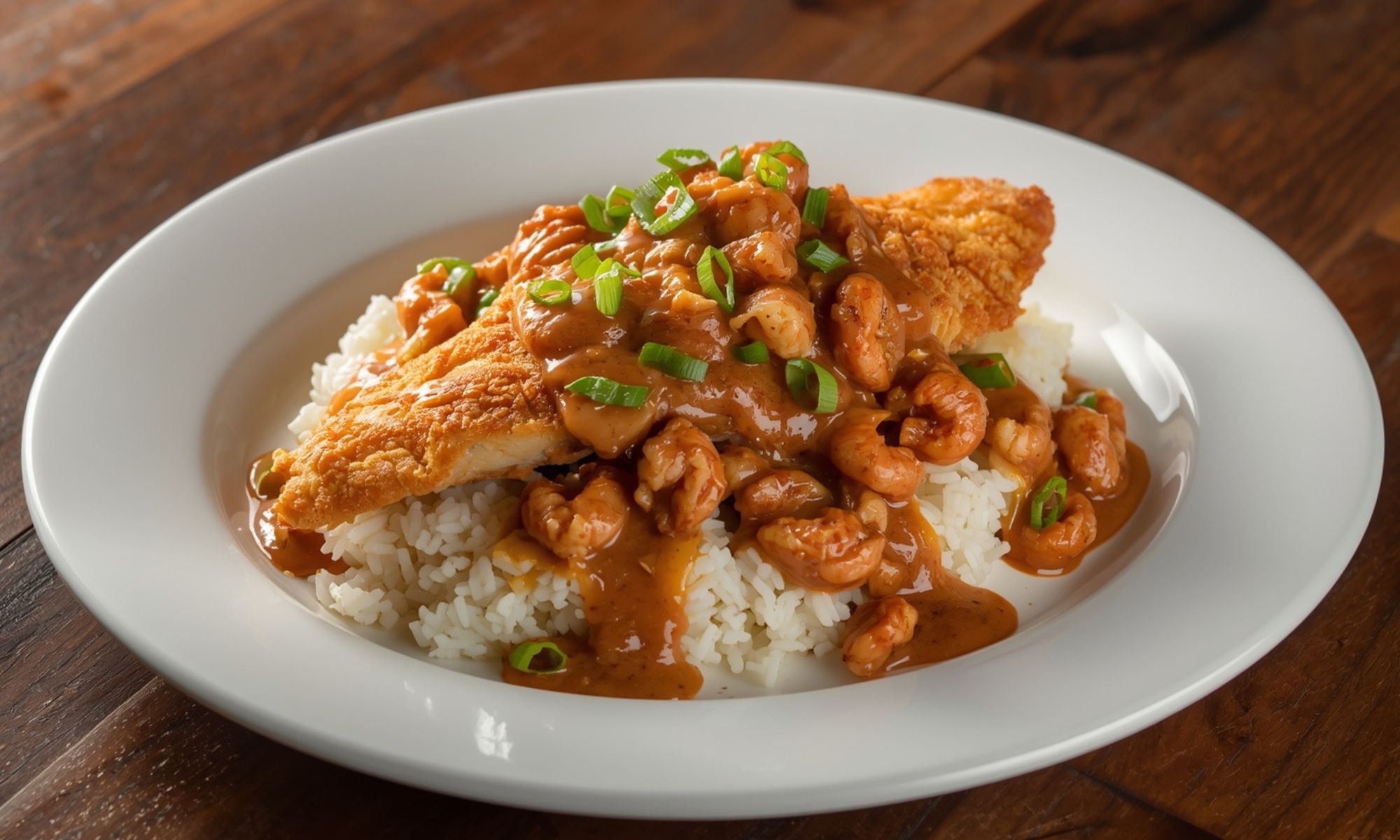It was one of those nights when the office followed me home, emails still buzzing, laundry untouched, and dinner begging to be figured out. You know that moment when you’re drained but still need something real on the table? Takeout felt easy, but my taste buds wanted comfort with attitude.
That’s when I spotted the catfish waiting in the fridge. No grand plan, just me, a hot skillet, and the decision that Catfish Atchafalaya was about to save my night. Butter started to sizzle, garlic hit the pan, and suddenly my kitchen smelled like it was celebrating instead of stressing.
The peppers and onions lit up the pan with color, spices kicked in like background music, and the sauce bubbled to life, thick and velvety. Each piece of catfish soaked up that bold flavor until it looked and smelled like pure Louisiana comfort on a plate.
By the first bite, I wasn’t just feeding myself, I was unwinding. Quick, soulful, and impossible not to love, this recipe proves dinner can be both weeknight easy and celebration worthy. Stick with me, because once you taste Catfish Atchafalaya, you’ll wonder how you ever survived without it
Why This Catfish Atchafalaya Recipe Changes Everything

Catfish Atchafalaya isn’t your typical fried fish dinner.
This Louisiana masterpiece tells our cultural story. French techniques meet African spices perfectly. Spanish influences dance with Native American wisdom perfectly. It’s history you can taste on your plate.
The fish gets a complex spice rub first. Then we pan sear it to golden perfection. The sauce combines the holy trinity beautifully. Fresh herbs and white wine complete the magic.
Every bite delivers layers of flavor that unfold slowly. First you taste the perfectly seasoned catfish. Then the aromatic vegetables hit your palate. Finally, that rich sauce ties everything together like a warm Louisiana hug.
This recipe works magic on dinner parties too. It looks impressive but won’t stress you out. Most of the prep happens beforehand. When guests arrive, you’re just doing some quick searing and sauce making.
The best part? It’s surprisingly healthy for something that tastes this indulgent. We’re not drowning anything in heavy cream or butter. Just clean flavors that let that beautiful catfish shine through.
Ingredients & Smart Swaps
The Star Players
- 4 catfish fillets (6-8 oz each), skin removed
- 2 tablespoons Creole seasoning (homemade or store bought)
- 1 large yellow onion, diced
- 1 bell pepper, diced (green for traditional, red for sweetness)
- 2 celery stalks, diced fine
- 4 garlic cloves, minced
- 1 can (14.5 oz) diced tomatoes, drained
- 1/2 cup dry white wine
- 1 cup seafood stock (or chicken stock)
- 2 bay leaves
- 1/4 cup fresh parsley, chopped
- 2 green onions, sliced thin
- 3 tablespoons vegetable oil
- 2 tablespoons butter
- Salt and black pepper to taste
- Hot sauce for serving
The Creole Seasoning Blend (Make Your Own!)
If you’re making your own Creole seasoning, and honey, you should, here’s what goes in:
- 2 tablespoons paprika
- 1 tablespoon garlic powder
- 1 tablespoon onion powder
- 1 tablespoon dried oregano
- 1 tablespoon dried thyme
- 1 teaspoon cayenne pepper (adjust to taste)
- 1 teaspoon black pepper
- 1 teaspoon white pepper
- 1 teaspoon salt
Mix it all up. Store in an airtight container. Use it on everything.
Smart Ingredient Swaps
Can’t find catfish? Red snapper or tilapia work beautifully. Just adjust cooking time since they’re more delicate.
No white wine? Use additional stock plus lemon juice. The acid balances everything perfectly.
Fresh herbs not available? Dried works fine. Use about half the amount.
Don’t have seafood stock? Chicken stock is perfect. Vegetable stock works too.
Bell peppers expensive? Frozen bell pepper mix saves money. Tastes great in this dish.
Step by Step Magic for Catfish Atchafalaya Recipe

Getting Your Mise en Place Ready
First things first, get everything prepped and ready. This dish moves fast once you start cooking.
Pat those catfish fillets completely dry with paper towels. Season both sides generously with your Creole seasoning. Let them sit at room temperature for 20 minutes.
Meanwhile, dice your holy trinity, onions, bell peppers, and celery. Keep them separate for now. Mince that garlic. Drain your tomatoes. Have everything within arm’s reach of your stove.
Open that wine and pour yourself a small glass. You’ve earned it.
Mastering the Perfect Catfish Atchafalaya Technique
Heat a large, heavy skillet over medium high heat. Cast iron works perfectly here. Add vegetable oil and let it shimmer beautifully.
Gently lay the catfish fillets in the pan. Don’t crowd them, work in batches if needed. The fish should sizzle immediately when it hits the oil.
Here’s the crucial part: don’t mess with them! Let them sear undisturbed for 3-4 minutes. You’ll know they’re ready to flip when the edges start looking opaque.
Flip carefully and cook another 3-4 minutes. The fish is done when it flakes easily with a fork. Internal temperature should hit 145°F if you’re using a thermometer.
Transfer the fish to a warm plate. Cover loosely with foil.
Building That Incredible Sauce
In the same pan (don’t clean it!), reduce heat to medium. Add the butter and let it melt.
Toss in your diced onions first. They need the longest cooking time. Sauté for about 3 minutes until they start getting soft and translucent.
Add the bell peppers next. Cook for 2 minutes. Then the celery goes in for another minute. Everything should be getting tender but still have some bite.
Now comes the garlic. Add it and stir constantly for 30 seconds. Work quickly here, burnt garlic ruins everything.
Pour in that white wine and scrape up any brown bits from the bottom of the pan. Those bits are pure flavor gold. Let the wine bubble and reduce by about half.
Add the drained tomatoes, seafood stock, and bay leaves. Bring everything to a gentle simmer. Let it cook for about 10 minutes, stirring occasionally.
The sauce should thicken slightly and all the flavors should meld together beautifully.
Bringing It All Together
Taste your sauce and adjust seasoning. Needs more salt? Add it. Want more heat? Splash in some hot sauce or cayenne.
Nestle those gorgeous catfish fillets back into the sauce. Spoon some sauce over the tops. Let everything warm through for about 2 minutes.
Remove the bay leaves, nobody wants to bite into one of those.
Sprinkle with fresh parsley and green onions. The bright green herbs make everything pop visually.
Common Mistakes to Dodge
Don’t overcook the catfish. It goes from perfect to rubber quickly. Pull it out when it flakes easily with gentle pressure.
Never skip the drying step. Wet fish steams instead of searing properly.
Don’t rush the vegetable cooking process. Those onions need time to develop sweetness.
Watch your heat levels carefully. Too high burns everything before it cooks through.
The Science Behind the Sizzle
Why We Sear First
Searing creates something called the Maillard reaction. It’s basically controlled browning that develops hundreds of new flavor compounds. Those golden brown bits on your catfish? That’s pure deliciousness right there.
The key is getting the pan hot enough before adding the fish. Too cool, and you’ll just steam the protein. Too hot, and you’ll burn the outside before the inside cooks through.
That’s why we use medium high heat with oil that has a high smoke point. Vegetable oil works perfectly here.
The Holy Trinity Science
Onions, bell peppers, and celery aren’t just tradition. They’re chemistry.
Onions provide natural sugars that caramelize and add sweetness. They also contain sulfur compounds that create that distinctive savory depth.
Bell peppers add color, mild sweetness, and important vitamins. They also provide texture contrast.
Celery brings a subtle herbal note and natural sodium. It also contains compounds that enhance other flavors in the dish.
When you cook them in the proper order, each ingredient has time to contribute its best qualities without getting overcooked.
Wine in Cooking Explained
The alcohol in wine serves several purposes. It dissolves flavor compounds that aren’t water soluble. It also provides acidity that brightens the entire dish.
When wine hits the hot pan, the alcohol evaporates quickly. What remains is concentrated flavor and natural fruit acids. These acids help tenderize the fish and balance the richness of the sauce.
That’s why we let it reduce by half. We’re concentrating the good stuff and letting the harsh alcohol notes disappear.
Understanding Catfish
Catfish is naturally sweet and mild because of what they eat. Atchafalaya Basin catfish feed on clean river bottom foods like crawfish, shrimp, and aquatic plants.
The flesh is relatively firm but cooks quickly. It’s also forgiving, a little overcooking won’t ruin it completely like it would with more delicate fish.
Catfish also absorbs flavors beautifully. That’s why the spice rub works so well. The fish takes on all those Creole seasonings while maintaining its natural sweetness.
Making It Beautiful & Delicious

Plating Like a Restaurant Pro
Start with warmed plates. Cold plates make hot food cool down too fast.
Spoon a generous portion of that gorgeous sauce right in the center of the plate. Let it pool naturally, don’t spread it around.
Place the catfish fillet on top of the sauce, slightly off center. This creates visual interest and shows off both components.
Spoon a little extra sauce over the fish. Not too much, you want to see that beautiful golden crust you worked so hard for.
Sprinkle fresh herbs around the plate, not just on the fish. This ties the whole presentation together.
A final twist of black pepper adds color contrast and shows attention to detail.
Perfect Pairings
This Catfish Atchafalaya deserves thoughtful accompaniments.
For sides, think about textures and flavors that complement without competing. Creamy grits are traditional and perfect. The smooth texture contrasts beautifully with the flaky fish.
Dirty rice adds earthiness and makes the meal more substantial. Plus it soaks up that incredible sauce.
Simple steamed green beans or asparagus provide color and freshness. Keep the seasoning light, maybe just butter and lemon.
For bread, crusty French bread is essential. You’ll want something to soak up every drop of sauce.
Wine Pairing Magic
A crisp Sauvignon Blanc echoes the wine used in cooking. The acidity cuts through the richness perfectly.
Pinot Grigio works beautifully too. Its clean, mineral notes complement the catfish without overwhelming it.
Feeling fancy? A good Chablis brings elegance to the table. The French connection makes sense with the Creole cooking style.
For red wine lovers, a light Pinot Noir can work. Choose something fruit forward, not too tannic.
Beer drinkers should grab a clean lager or wheat beer. Nothing too hoppy or it’ll clash with the delicate fish flavors.
Wrapping It Up
Catfish Atchafalaya represents everything beautiful about Louisiana cooking. It’s simple ingredients transformed into something extraordinary through technique and love.
This dish connects you to generations of cooks who understood that food isn’t just fuel. It’s culture, history, and happiness all rolled into one perfect bite.
The beauty lies in its versatility too. Make it for a weeknight dinner when you want something special. Serve it at your next dinner party and watch everyone ask for the recipe. It works every single time.
Remember these key points: respect your ingredients, don’t rush the process, and taste as you go. Cooking is a conversation between you and the food. Listen to what it’s telling you.
Most importantly, make this recipe your own. Maybe you like more heat, add extra cayenne. Prefer milder flavors? Cut back on the spice. That’s the Louisiana way, take what works and make it yours.
Once you master this base recipe, endless possibilities unfold. Try different fish varieties. Add okra for extra thickness. Throw in andouille sausage for smokiness.
The Catfish Atchafalaya tradition continues through your kitchen now.
Keep practicing, keep tasting, and keep having fun in the kitchen. That’s where all the magic really happens.
Frequently Asked Questions: Catfish Atchafalaya Recipe
Can I make Catfish Atchafalaya ahead of time?
Absolutely! This dish actually improves with a little time for the flavors to meld. Cook everything completely, then store in the refrigerator for up to two days. Reheat gently on the stovetop, adding a splash of stock if the sauce gets too thick. Just don’t reheat in the microwave, it’ll make the fish rubbery. The stovetop method keeps everything tender and delicious.
What if I can’t find fresh catfish in my area?
Frozen catfish works perfectly fine for this recipe. Just make sure to thaw it completely in the refrigerator overnight. Pat it extra dry before seasoning since frozen fish tends to release more moisture. You might need an extra minute or two of cooking time, but the results will be just as delicious. Some grocery stores can special order fresh catfish if you ask nicely.
How do I know when the catfish is perfectly cooked?
The fish should flake easily when gently pressed with a fork. It should hold together but not look translucent anywhere. If you prefer using a thermometer, 145°F is your target. Visual cues work just as well – the flesh turns completely opaque when done. Better to slightly undercook than overdo it. Remember, the fish will continue to cook slightly in the hot sauce, so pulling it off the heat just before perfection ensures the best texture.
Can I substitute the wine with something non alcoholic?
Sure thing! Replace the wine with additional seafood or chicken stock plus a tablespoon of white wine vinegar or lemon juice. The acid is what’s important for balancing the flavors and helping to deglaze the pan. Apple juice mixed with a little vinegar also works surprisingly well. You’ll still get great flavor without any alcohol.
What’s the best way to store and reheat leftovers?
Store the fish and sauce together in an airtight container in the refrigerator for up to three days. To reheat, use a skillet over medium low heat with a splash of stock or water to prevent sticking. Cover the pan and heat gently until warmed through, about 5-7 minutes. This keeps the fish tender and prevents the sauce from separating. Never microwave leftovers, it ruins the texture completely.

Swiftly Captions by Tina Smith — Quick, flavorful food recipes made simple, bringing fresh inspiration to your kitchen every day






